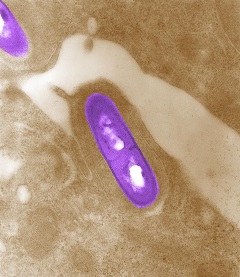What is Listeria (Listeriosis)?

According to the Centers for Disease Control and Prevention, Listeriosis is a serious infection usually caused by eating food contaminated with the bacterium Listeria monocytogenes(Lm). Lm is ubiquitous, and thrives in environments that could be perceived as clean, i.e. cold, wet spaces.
What can consumers do to protect themselves from Lm?
The FDA and CDC recommend consumers take the following actions to prevent an infection from Listeria:
- Follow FDA directions for safe washing and handling food. Find consumer resources on safe food handling at The Partnership for Food Safety Education.
- Keep your kitchen and environment cleaner and safer.
- Cook meat and poultry thoroughly.
- Store foods safely.
- Choose safer foods (i.e.: avoiding unpastuerized products).
Who is most at risk for Listeria?
The CDC outlines the following groups that are at increased risk:
- Pregnant women:Pregnant women are about 10 times more likely than the general population to get listeriosis. About one in seven (14%) cases of listeriosis occurs during pregnancy.
- Newborn babies:Newborn babies suffer the most serious effects of infection in pregnancy.
- People with weakened immune systems: Individuals within this group also have a higher risk for Listeria infection due to underlying medical conditions such as cancer and immunosuppresive therapy (i.e., steroids, chemotherapy, radiation), liver or kidney disease, diabetes, alcoholism, and HIV/AIDS.
- Older Adults: Adults 65 years and older are about 4 times more likely than the general population to get Listeria infection.
FMI Resources
- FMI Resources Listeria Action Plan for Retail Delis, 2012
- Listeria Action Plan for Retailers, 2016
- Webinar by FMI's VP of Food Safety Hilary Thesmar on the Listeria Action Plan, 2013
- Guidance for the Control of Listeria Monocytogenes Risks in Retail Food Stores, 2008
- FMI Interagency Retail Lm Risk Assessment Briefing | Presentation Slides, 2013
- Help Shoppers Avoid "Danger Zone" with Go 40°F or Below, 2015
- Listeria - Beyond the Deli, 2015
- 2015 IAFP Presentation Slides: Listeria Action Plan for Retail Delis
Risk Assessments
Interagency Risk Assessment: Listeria monocytogenes in Retail Delicatessens Technical Report | Interpretive Summary, September 2013
Quantitative Assessment of Relative Risk to Public Health From Foodborne Listeria monocytogenes Among Selected Categories of Ready-to-Eat Foods Full Assessment | Interpretive Summary, September 2003
Relative Risk to Public Health From Foodborne Listeria monocytogenes Among Selected Categories of Ready-to-Eat Foods
Full Assessment | Interpretive Summary, September 2003
Other Government Resources
- FDA Bad Bug Book 2nd Edition on foodborne pathogens
- FDA Commercial Deli Slicer Inspection Tips for Food Safety Professionals
- CDC Information Page on Listeria
Photo Reference: CDC
- Food Safety & Security
 Industry Topics address your specific area of expertise with resources, reports, events and more.
Industry Topics address your specific area of expertise with resources, reports, events and more.
 Our Research covers consumer behavior and retail operation benchmarks so you can make informed business decisions.
Our Research covers consumer behavior and retail operation benchmarks so you can make informed business decisions.
 Events and Education including online and in-person help you advance your food retail career.
Events and Education including online and in-person help you advance your food retail career.
 Food Safety training, resources and guidance that help you create a company food safety culture.
Food Safety training, resources and guidance that help you create a company food safety culture.
 Government Affairs work — federal and state — on the latest food industry policy, regulatory and legislative issues.
Government Affairs work — federal and state — on the latest food industry policy, regulatory and legislative issues.
 Get Involved. From industry awards to newsletters and committees, these resources help you take advantage of your membership.
Get Involved. From industry awards to newsletters and committees, these resources help you take advantage of your membership.
 Best practices, guidance documents, infographics, signage and more for the food industry on the COVID-19 pandemic.
Best practices, guidance documents, infographics, signage and more for the food industry on the COVID-19 pandemic.
